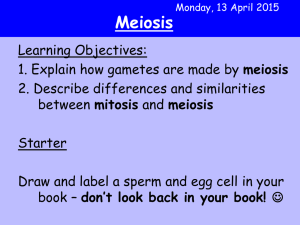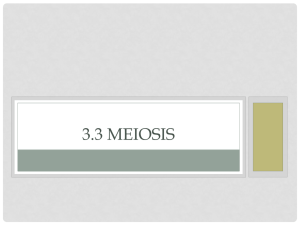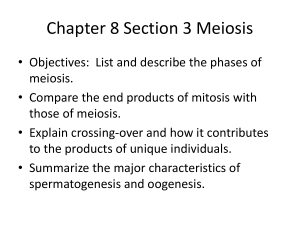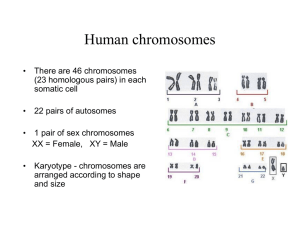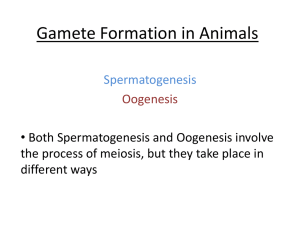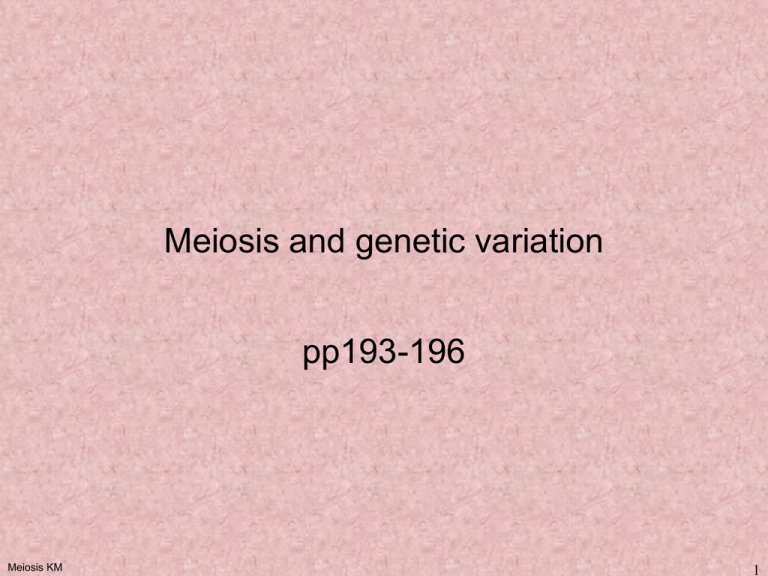
Meiosis and genetic variation
pp193-196
Meiosis KM
1
Genome
• Genome: Complete complement of an
organism’s DNA.
– Includes genes (control traits) and noncoding DNA organized in chromosomes.
Meiosis KM
2
Genes
• Eukaryotic DNA is
organized in chromosomes.
– Genes have specific places
on chromosomes.
Meiosis KM
3
Heredity
• Heredity – way of
transferring genetic
information to
offspring
• Chromosome theory of
heredity:
chromosomes carry
genes.
• Gene – “unit of
heredity”.
Meiosis KM
4
Reproduction
• Asexual
– Many single-celled organisms reproduce
by splitting, budding, parthenogenesis.
– Some multicellular organisms can
reproduce asexually, produce clones
(offspring genetically identical to parent).
Meiosis KM
5
Sexual reproduction
• Fusion of two gametes to produce a
single zygote.
• Introduces greater genetic variation,
allows genetic recombination.
• With exception of self-fertilizing
organisms (e.g. some plants), zygote
has gametes from two different parents.
Meiosis KM
6
Meiosis KM
7
Chromosomes
• Karyotype:
– ordered display of an individual’s
chromosomes.
– Collection of chromosomes from mitotic
cells.
– Staining can reveal visible band patterns,
gross anomalies.
Meiosis KM
8
Karyotyping
Meiosis KM
9
Meiosis KM
10
Meiosis KM
11
Meiosis KM
12
Karyotype Activity
http://gslc.genetics.utah.edu/units/disorders/karyotype/karyotype.cfm
Meiosis KM
13
Homologues
• Chromosomes exist in homologous
pairs in diploid cells.
Exception: Sex chromosomes (X, Y).
Other chromosomes are known as autosomes,
they have homologues.
Meiosis KM
14
In humans …
• 23 chromosomes donated by each parent
(total = 46 or 23 pairs).
• Gametes (sperm/ova):
– Contain 22 autosomes and 1 sex chromosome.
– Are haploid (haploid number “n” = 23 in humans).
• Fertilization/syngamy results in zygote with 2
haploid sets of chromosomes - now diploid.
– Diploid cell; 2n = 46. (n=23 in humans)
• Most cells in the body produced by mitosis.
• Only gametes are produced by meiosis.
Meiosis KM
15
Chromosome numbers
All are even numbers –
diploid (2n) sets of
homologous
chromosomes!
Ploidy = number of
copies of each
chromosome.
Diploidy
Meiosis KM
16
Meiosis – key differences from mitosis
•
•
•
•
Meiosis reduces the number of chromosomes by half.
Daughter cells differ from parent, and each other.
Meiosis involves two divisions, Mitosis only one.
Meiosis I involves:
– Synapsis – homologous chromosomes pair up.
Chiasmata form (crossing over of non-sister
chromatids).
– In Metaphase I, homologous pairs line up at
metaphase plate.
– In Anaphase I, sister chromatids do NOT separate.
– Overall, separation of homologous pairs of
chromosomes, rather than sister chromatids of
individual chromosome.
Meiosis KM
17
Meiosis KM
18
Meiosis KM
19
Meiosis KM
20
Animation
Meiosis KM
21
Meiosis 1
First division of meiosis
• Prophase 1: Each chromosome dupicates
and remains closely associated. These are
called sister chromatids. Crossing-over can
occur during the latter part of this stage.
• Metaphase 1: Homologous chromosomes
align at the equatorial plate.
• Anaphase 1: Homologous pairs separate
with sister chromatids remaining together.
• Telophase 1: Two daughter cells are formed
with each daughter containing only one
chromosome of the homologous pair.
Meiosis KM
22
Meiosis II
Second division of meiosis: Gamete formation
• Prophase 2: DNA does not replicate.
• Metaphase 2: Chromosomes align at
the equatorial plate.
• Anaphase 2: Centromeres divide and
sister chromatids migrate separately to
each pole.
• Telophase 2: Cell division is complete.
Four haploid daughter cells are
obtained.
Meiosis KM
23
Mitosis vs. meiosis
Meiosis KM
24
Meiosis KM
25
Meiosis creates genetic variation
• During normal cell growth, mitosis produces
daughter cells identical to parent cell (2n
to 2n)
• Meiosis results in genetic variation by
shuffling of maternal and paternal
chromosomes and crossing over.
No daughter cells formed during meiosis
are genetically identical to either mother or
father
During sexual reproduction, fusion of the
unique haploid gametes produces truly
unique offspring.
Meiosis KM
26
Independent assortment
Meiosis KM
27
Independent assortment
Number of combinations: 2n
e.g. 2 chromosomes in haploid
2n = 4; n = 2
2n = 22 = 4 possible combinations
Meiosis KM
28
In humans
e.g. 23 chromosomes in haploid
2n = 46; n = 23
2n = 223 = ~ 8 million possible combinations!
Meiosis KM
29
Crossing over
Chiasmata – sites of crossing
over, occur in synapsis.
Exchange of genetic material
between non-sister chromatids.
Crossing over produces
recombinant chromosomes.
Meiosis KM
30
Harlequin chromosomes
Meiosis KM
31
Random fertilization
At least 8 million combinations from Mom,
and another 8 million from Dad …
>64 trillion combinations for a diploid
zygote!!!
Meiosis KM
32
Meiosis & sexual life cycles
• Life cycle = sequence
of stages in organisms
reproductive history;
conception to
reproduction.
• Somatic cells = any
cell other than
gametes, most of the
cells in the body.
• Gametes produced by Generalized animal life cycle
meiosis.
Meiosis KM
33
Meiosis KM
34
Sex is costly!
• Large amounts of energy required to find a
mate and do the mating: specialized
structures and behavior required
• Intimate contact provides route for infection
by parasites (AIDS, syphillis, etc.)
• Genetic costs: in sex, we pass on only half of
genes to offspring.
• Males are an expensive luxury - in most
species they contribute little to rearing
offspring.
Meiosis KM
35
But …
• More genetic diversity: more potential for survival
of species when environmental conditions
change.
– Shuffling of genes in meiosis
– Crossing-over in meiosis
– Fertilization: combines genes from 2 separate
individuals
• DNA back-up and repair.
– Asexual organisms don't have back-up copies of
genes, sexual organisms have 2 sets of chromosomes
and one can act as a back-up if the other is damaged.
– Sexual mechanisms, especially recombination, are
used to repair damaged DNA - the undamaged
chromosome acts as a template and eventually both
chromosomes end up with the correct gene.
Meiosis KM
36
Vocabulary
•
•
•
•
•
•
Meiosis KM
centriole
centromere:
crossing over:
gamete:
meiosis:
zygote:
37
Study Questions
• 1. What happens as homologous
chromosomes pair up during prophase I
of meiosis?
• 2. How does metaphase of mitosis
differ from metaphase I of meiosis?
• 3. What is the sole purpose of
meiosis?
• 4. What specific activities, involving
DNA, occur during interphase prior to
both mitosis and meiosis?
Meiosis KM
38
•
•
•
•
Meiosis KM
5. Compare mitosis and meiosis on the
following points:
a. number of daughter cells
produced.
b. the amount of DNA in the
daughter cells in contrast to the original
cell.
c. mechanism for introducing
genetic variation.
6. What is a zygote and how is it
formed?
7. Draw a nucleotide and then draw a
39

